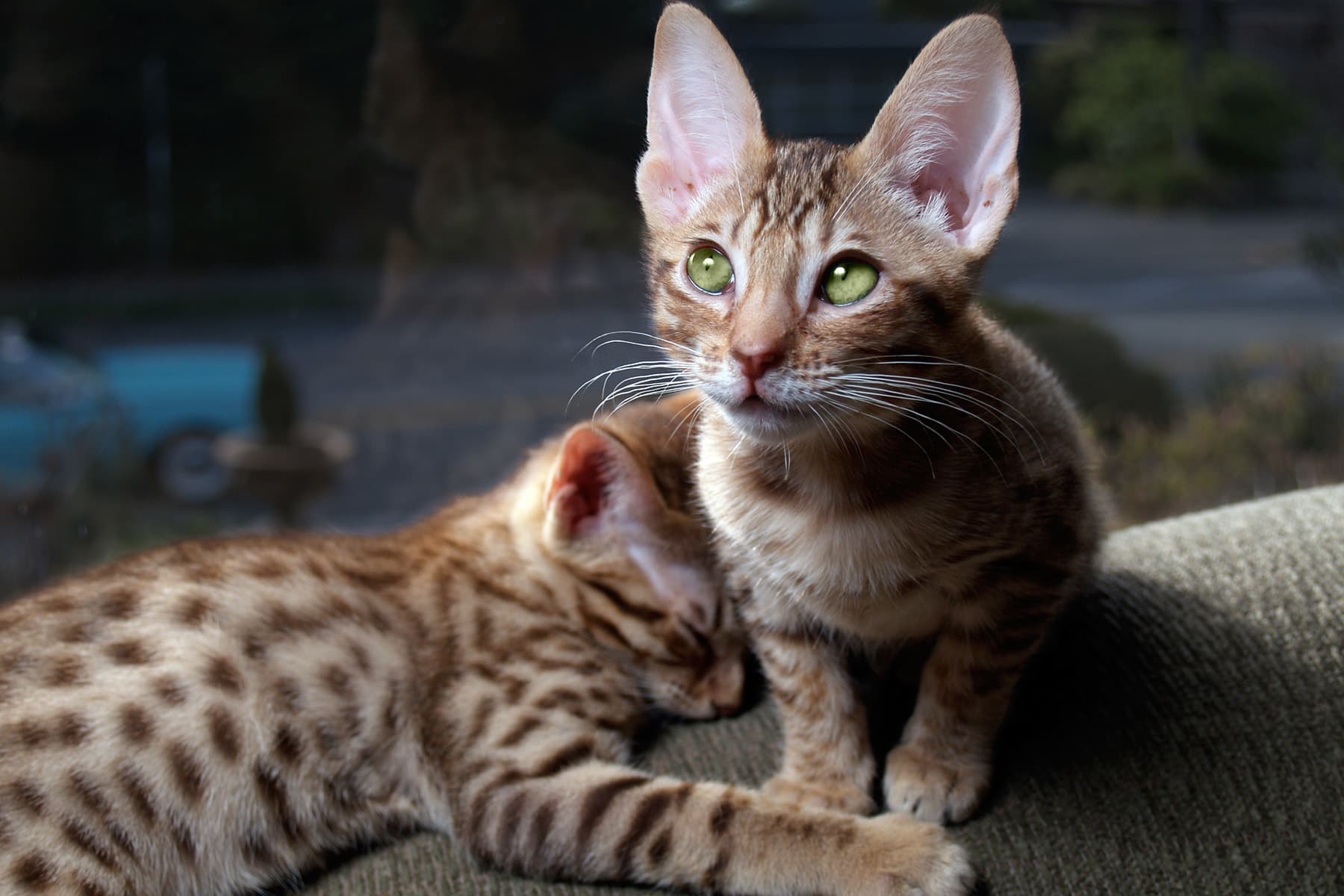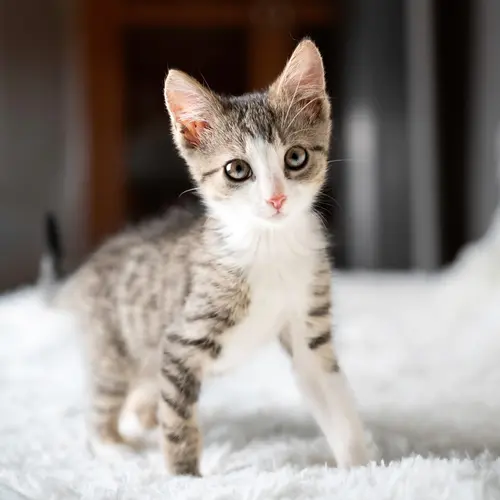
The Ocicat looks like a wild animal with their spotted coat but is actually a very sociable and friendly domestic cat. Their unique coat pattern gives them a look that’s similar to other cats in the wild, like margays, leopards, and ocelots, whose name Ocicat is derived from. Despite their appearance, the Ocicat personality is friendly, playful, and affectionate. They get along well with children and other animals, which makes them great house pets.
Characteristics of Ocicats
The Ocicat cat has a muscular and powerful body. Though not very large cats by size, they pack a lot of power and lean muscle into their athletic body. Male Ocicats usually weigh between 9 and 14 pounds, while females weigh slightly less at 6 to 9 pounds. They have large, slightly angled almond-shaped eyes and a short, tight coat that gives them the look of an animal that's always ready to spring into action. The average Ocicat lifespan is 15 to 18 years.
Although the Ocicat is mainly recognized for the thumb-shaped spots covering their body, their coat comes in four other patterns: ticked, classic tabby, solid, and pointed. Originally, the Ocicat had six different colors: tawny, chocolate, cinnamon, blue, lilac, and fawn. Due to an error by The Cat Fanciers’ Association, the American Shorthair was introduced to the breeding of the original Ocicat, giving the breed a larger bone structure and adding a silver base to the original six colors. Now, the Ocicat is available in 12 colors.
The Ocicat personality is known to be amenable, devoted, and outgoing. They are confident cats that are always looking for opportunities to play games and are not afraid to curl up on a stranger’s lap. Their social nature means they thrive in situations with many activities and do well in families that can give them a lot of attention. It also means that the Ocicat can become unhappy and depressed if they're left alone for long periods of time. The Ocicat is an ideal pet if you have a busy, active household that can give your Ocicat the attention they desire.
The Ocicat cat is very bright and can quickly learn to play a variety of games, including fetch. Because of these Ocicat characteristics, many people describe them as very doglike. Ocicats love their toys and can become possessive of what they think is theirs. You may encounter bouts of tug of war when trying to put away your Ocicat’s toys.
Caring for Ocicats
The Ocicat has a short, tight coat that requires very little maintenance. You can keep their coat in great condition by running a rubber brush over it weekly, which helps remove dead hairs. Use a chamois to polish their coat afterward to add some shine to it. If you decide to give your Ocicat a bath, choose a shampoo that can highlight the different colors and tones of their coat. Use a bronze-tone shampoo for cats with brown, chocolate, and cinnamon spots, a pearl-tone shampoo for cats with blue, lilac, and fawn coat colors, and a whitening shampoo for silver Ocicats.
The average Ocicat eats about 10 to 15 times a day, just a few nibbles at a time. Usually, the method of feeding an Ocicat at flexible times works for most, but pay attention to your cat’s specific habits. Some Ocicats may get bored and channel that into eating more food. Since being overweight is a common problem among domestic cats, it’s important to feed your Ocicat an age-appropriate, high-quality feline diet and to exercise your cat regularly. Spend time engaging your Ocicat in daily play sessions with high-activity toys to ensure they keep their mind and body sharp and healthy. Ocicats generally have good teeth, and you can help keep them healthy by brushing your Ocicat cat’s teeth at least twice a week.
Ocicats are susceptible to bacterial and viral infections like rabies and panleukopenia, which is a highly contagious disease that kills bone marrow and intestinal cells. Getting your Ocicat their “core” vaccines can help protect them from these dangerous diseases.
You should also take your Ocicat to the vet to get wellness exams on a regular basis, ideally twice a year. During these exams, your vet will run tests and check your Ocicat cat’s stool sample for parasites. Worms, fleas, and ticks can make their way into your cat’s skin and ears, so early detection helps increase the effectiveness of preventive medication to ease these problems. Prevention is also key for heartworms because there is currently no treatment available.
These parasites can cause pain, discomfort, and even death for your Ocicat. Some of these parasites can also be transmitted to humans in the household and cause health problems for them. Help your Ocicat stay healthy by providing them with clean water to drink and regular visits to the vet.
Health Problems to Watch for With Ocicats
Ocicat cats can have health issues that are genetic or common among most cats. Ocicats are at risk for a common genetic heart disease called hypertrophic cardiomyopathy (HCM). This disease can result in heart failure and death. Symptoms that your cat may show include labored and rapid breathing, lethargy, and a poor appetite, though many cats with HCM do not appear ill. That’s why it’s important to take your Ocicat for regular wellness exams, where the vet may be able to detect the problem early on through specific diagnoses. HCM has no known cure, but a specialized care plan that includes medication and therapy can help manage the condition.
Another genetic disease that may affect the Ocicat is progressive retinal atrophy, which results in the atrophy, or degeneration, of the retina. This disease can lead to a quick decline in your cat’s vision and in some cases lead to blindness. If your Ocicat is affected by this condition, you may start noticing them becoming more disoriented or bumping into objects more frequently. The onset of progressive retinal atrophy happens at around 1.5 to 2 years of age, followed by progressive loss of vision. Complete blindness usually happens at around 3 to 4 years of age. At present, there’s no effective treatment for this disease.
The Ocicat is also susceptible to renal amyloidosis, a potentially deadly disease caused by the accumulation of abnormal proteins called “amyloid” in your cat’s kidney. When this happens, the amyloid displaces normal cells and can cause inflammation in the kidney, resulting in severe organ damage or even failure. Several factors may lead to renal amyloidosis in your Ocicat, including genetic disposition, age, and having pre-existing conditions.
Symptoms of renal amyloidosis may be similar to those of other kidney diseases and include frequent urination, excessive thirst, and vomiting and weight loss. Because the damaged kidney is unable to concentrate urine, your cat will drink and urinate more because they’ll always feel thirsty. Your vet can diagnose renal amyloidosis by performing an exhaustive exam that may include X-rays and biopsy. There's no cure for the disease, but managing the symptoms with medication and dietary therapy may slow the disease progression and prolong your Ocicat’s life.
Special Considerations for Ocicats
For a busy household with children and other pets, the Ocicat makes a great pet due to their outgoing personality and adaptable nature. They are highly intelligent and can be taught to learn household rules and tricks.
The Ocicat personality is playful and energetic, making them good with families that are sociable and active. While not very noisy or overly clingy, the Ocicat can make themselves vocal when interacting with others or playing games. They are the ideal companion for households where someone is around most of the time.
The Ocicat can be allergic to pollen, mold, or dust and may show signs in the form of itchy skin. Most commonly, the skin of their legs, stomach, face, and ears may become itchy. Symptoms may include excessive grooming of specific areas, rubbing of their faces, and frequent ear infections. Many treatment options are available to help ease your cat’s condition.
History of Ocicats
Today’s Ocicat originates from the interbreeding of Abyssinian and Siamese cats, and in some cases the American Shorthair as well. They are domestic cats selectively bred to mimic the coat patterns and physical characteristics of cats in the wild.
The first Ocicat was the accidental result of breeding done by Virginia Dalai in 1964. Her goal was to develop a Siamese with points the same color as an Abyssinian. To do so, she bred an Abyssinian male with a cinnamon color with a large seal point Siamese female. The resulting kittens all had physical characteristics like the Abyssinian. Dalai kept a female from the litter that she named Dalai She.
Dalai then bred Dalai She with a chocolate point Siamese, which resulted in Siamese with Abyssinian points. Dalai repeated the breeding. This time, she got an ivory kitten with golden spots that she named Tonga. Dalai’s daughter noticed that the cat looked like an Ocelot and referred to Tonga as an Ocicat. Thus, Tonga became the first member of the Ocicat breed.
The Ocicat's history continued when geneticist Dr. Clyde Keeler convinced Dalai to breed a cat similar to the extinct Egyptian Spotted Fishing Cat. Dalai eventually produced a tawny spotted male that she later bred with an American Shorthair. The resulting cats have the silver spotted coat now officially recognized as the Ocicat breed.
Since then, other breeds have become fascinated by the Ocicat and have developed new lines. In August 1986, The International Cat Association (TICA) finally granted champion status to the Ocicat. The Cat Fanciers’ Association followed suit in 1987. Today, Ocicats continue to be popular all over the world due to their wild cat look yet sweet temperament.
